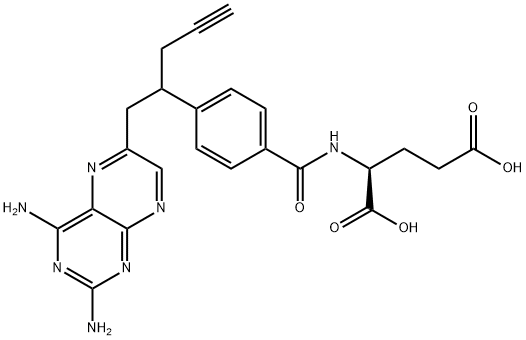10-Propargyl-10-deazaaminopterin

|
- ₹23300
- Product name: 10-Propargyl-10-deazaaminopterin
- CAS: 146464-95-1
- MF: C23H23N7O5
- MW: 477.47
- EINECS:
- MDL Number:MFCD00920897
- Synonyms:N-(4-(1-((2,4-Diamino-6-pteridinyl)methyl)-3-butynyl)benzoyl)-L-glutamic acid;10-Propargyl-10-deazaaminopterin;L-Glutamic acid, N-(4-(1-((2,4-diamino-6-pteridinyl)methyl)-3-butynyl)benzoyl)-;Unii-A8Q8I19Q20;FOLOTYN PRALATREXATE;N-(4-{1-[(2,4-diaMinopteridin-6-yl)Methyl]but-3-yn-1-yl}benzoyl)-L-glutaMic acid;N-[4-[1-[(2,4-DiaMino-6-pteridinyl)Methyl]-3-butyn-1-yl]benzoyl]-L-glutaMic Acid;(2S)-2-(4-(1-(2,4-diaMinopteridin-6-yl)pent-4-yn-2-yl)benzaMido)pentanedioic acid
1 prices
Selected condition:
Brand
- TCI Chemicals (India)
Package
- 100MG
- ManufacturerTCI Chemicals (India)
- Product numberP2645
- Product descriptionPralatrexate
- Packaging100MG
- Price₹23300
- Updated2022-05-26
- Buy
| Manufacturer | Product number | Product description | Packaging | Price | Updated | Buy |
|---|---|---|---|---|---|---|
| TCI Chemicals (India) | P2645 | Pralatrexate | 100MG | ₹23300 | 2022-05-26 | Buy |
Properties
Melting point :215 °C(dec.)
Density :1.471±0.06 g/cm3(Predicted)
storage temp. :2-8°C
Water Solubility :Insoluble in water
solubility :≥23.85 mg/mL in DMSO; insoluble in H2O; insoluble in EtOH
pka :3.53±0.10(Predicted)
form :powder to crystal
color :White to Light yellow
Density :1.471±0.06 g/cm3(Predicted)
storage temp. :2-8°C
Water Solubility :Insoluble in water
solubility :≥23.85 mg/mL in DMSO; insoluble in H2O; insoluble in EtOH
pka :3.53±0.10(Predicted)
form :powder to crystal
color :White to Light yellow
Safety Information
| Symbol(GHS): |
 
|
|||||||||||||||||||||
|---|---|---|---|---|---|---|---|---|---|---|---|---|---|---|---|---|---|---|---|---|---|---|
| Signal word: | Warning | |||||||||||||||||||||
| Hazard statements: |
|
|||||||||||||||||||||
| Precautionary statements: |
|
Description
Pralatrexate, an injectable DHFR inhibitor, was launched for the treatment of patients with relapsed or refractory PTCL. PTCL is an aggressive form of non-Hodgkin’s lymphoma (NHL) characterized by the proliferation of abnormal T-lymphocytes that circulate in the peripheral bloodstream. The inhibition of the folate enzymes DHFR and thymidylate synthase is a well-validated method of cancer treatment. In vitro, pralatrexate is slightly less potent than MTX in inhibiting DHFR derived from murine leukemia L1210 cells (Ki = 18.2 pM vs. 5.75 pM) and human leukemia CCRF-CEM cells (Ki = 13.4 pM vs. 5.4 pM). However, it is transported into both types of cells with 10-fold higher efficiency than MTX, thereby providing a more potent inhibition of cell growth as compared with MTX. In vivo, intraperitonally administered pralatrexate at 60 mg/ kg twice weekly for three or four doses caused complete lymphoma regressions in 89, 56, and 30% of HT, RL, and SKI-DLBCL-1 xenografted mice, respectively, whereas a similar dosing of MTX at 40 mg/kg twice weekly did not produce complete regression. The posttreatment tumor diameter was also smaller in pralatrexate-treated animals.Related product price
- L-Glutamic acid
₹252-105262.3 - Aminopterin
₹8010.5-251865.28 - Lithium diisopropylamide
₹5390.85-34012.15






